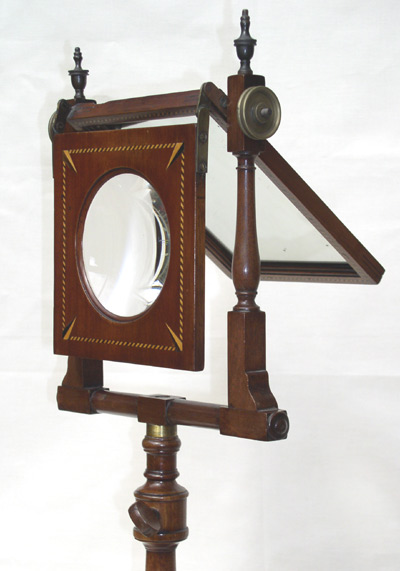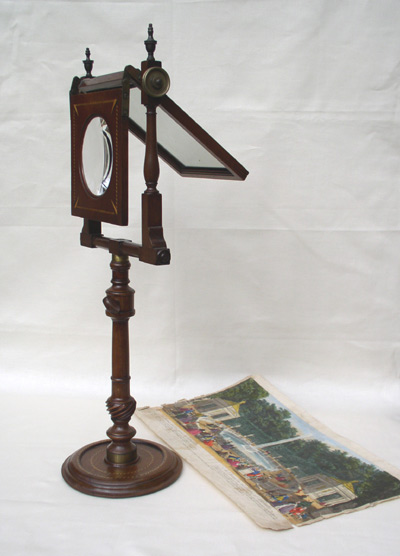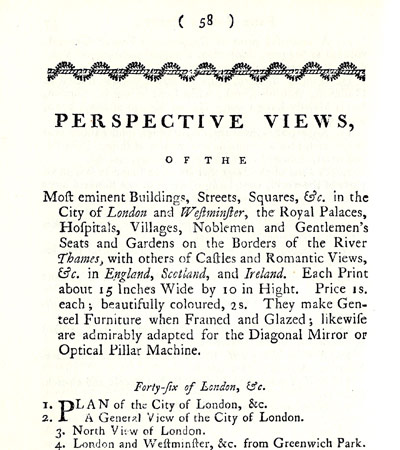|
THE ZOGRASCOPE
One of the fascinating byways of print collecting is to consider the various devices used for looking at prints. These have been more numerous than might be imagined. Today, they are usually grouped under the heading of ‘optical toys’.
 
On this page, we thought you might be interested in one of the most well known and popular of these from the Georgian era – the zograscope.
The zograscope, or ‘optical diagonal machine’, was used mostly in the C18 and first half of the C19 for viewing prints. These would mostly have been topographical views of places or buildings.
These in turn are normally known as perspective prints or vue d’optiques. This is because the views were normally constructed with a strong architectural perspective effect. We usually have a few of these types of prints in our stock, see prints for sale.
The zograscope has a large shallow convex lens, usually some 110 to 130 millimetres across. When the print is viewed through the lens, it seems to enhance the natural perspective of the image to give an almost three dimensional view.
Apparently, it was a fashionable pastime to look at prints in this way – for few people would have travelled far in that era and prints were an important means of communicating information. In the era of the ‘Playstation’, it all seems tame stuff, but in the C18, it was probably pretty exciting !!
Zograscopes with a lens only required the prints to be held vertically. For this reason prints were often pasted onto board, often having the edge painted in black. Thus this type of print is original in this form, and should be preserved as such and not removed from the board. If mounted prints have become damp, there can be conservation problems, but if kept in stable conditions, they are unlikely to deteriorate.
 The more sophisticated models also incorporated a mirror. This allowed the print to be laid down horizontally on a table, so that the viewer could sit at a seat and look into the lens. However, the effect of the mirror was to reverse the image. For this reason, many perspective prints are printed in reverse and/or have a title in reverse above the image. The more sophisticated models also incorporated a mirror. This allowed the print to be laid down horizontally on a table, so that the viewer could sit at a seat and look into the lens. However, the effect of the mirror was to reverse the image. For this reason, many perspective prints are printed in reverse and/or have a title in reverse above the image.
We should not be too scientific on this point, though, as we have seen the same print printed both ways round! With prints being copied (and pirated) in London, Paris and Augsburg just to name a few, often the printmaker may have never seen the original location – or known what copy he was working from.

The illustrations show a zograscope which we own ourselves. It is a very typical early C19 pillar model. Unusually, it has a maker’s name stamped on it. This moves it from being yet another anonymous artefact into something whose history and origins might be traced.
The name stamped on the top of the instrument is T FLOYD, in small square lettering. It is possible that this could be a retailer, but it seems to be more in the style of a maker’s mark, being so neat and inconspicuous.
The FHS Dictionary of Furniture Makers lists a Thomas Floyd, as a chair maker working in Chester, who died at the young age of 31 in 1831. The date would be about right for the style, and a chair maker would certainly have the skills for turning the uprights and assembly etc.
On the other hand, the metalwork and the lens used in the construction would seem to suggest a scientific instrument maker? Indeed, various writers on the subject (see below) generally suggest that these instruments were made by instrument makers. If anyone knows of a T Floyd do please let us know.

There is some interesting information published about the zograscope and the related perspective prints, although most descriptions tend to be short references in other books and articles.
Print catalogues of the period usually listed perspective prints. For example, Sayer and Bennett’s Catalogue of Prints 1775 has a section on perspective views, listing some 204 prints, 111 being views of London and the British Isles, the remainder mostly Continental views. 
In the preamble to the section, it states, “(Perspective views) make Genteel Furniture when Framed and Glazed; likewise are admirably adapted for the Diagonal Mirror or Optical Pillar Machine”.
A very interesting early article on the instrument was published in 1953, by J A Chaldecott (full refs to sources at the end). He provides much useful information, pointing out for example that in the C18 the use of the expression zograscope was rare, variations on the term ‘optical diagonal machine’ being more common.
Some of his scholarship has perhaps been superseded. For example, he states that perspective prints are rare in the UK, but this is not really true - they formed quite a significant part of the output of C18 prints and are still to be found.
There is a very useful review in Clayton (pages 140 to 141). He says that the optical effect was discovered around 1745 and that the first printed reference to the instruments in England was in a newspaper advertisement in April 1746. Unfortunately neither he nor the other writers suggest who actually invented the gadget!
Clayton states that there was an extraordinary expansion in the market for these perspective views from around this date, and lists a number of the print sellers / catalogues who provided prints.
The most thorough article we have found is Kees Kaldenbach’s Perspective Views (Print Quarterly), although here most of the emphasis not surprisingly is on the prints themselves. He suggests that the device originated in France, but again gives no corroboration. He does mention one maker, Edward Nairne, relating to an instrument in the Science Museum in London, also described in Chaldecott and Clayton.
More typical are shorter descriptions, such as in Richard Balzer’s excellent book Peepshows - A Visual History which illustrates a model and also the types of prints that might be viewed. The peepshow or ‘raree show’ was essentially a large wooden box, often up to 750 mm wide, into which prints were inserted. In this very interesting book, as well as the peepshow or raree show boxes, various viewing devices, including two styles of zograscope are illustrated.
Similarly Ted Stanley’s article on conserving The Polyrama Panoptique . . . illustrates a zograscope, before moving to the main theme of discussing the paper restoration project.
A trawl of the Internet provided a surprising number of references to zograscopes, but on examination most proved to be quite short derivative descriptions.

In general, there seems to be a lack of information as to who made these devices, how the particular designs and styles evolved, trade references, sellers etc. If you are interested, we hope that the above information will give you pointers to start with. If you unearth any interesting information, do let us know!
Refs
Balzer, Richard (1998) Peepshows: A Visual History Harry N Abrams, New York.
The text is quite short, the bulk of the book being given over to 180 antique print illustrations showing peepshows in use.
Chaldecott, J A (1953) The Zograscope or Optical Diagonal Machine Annals of Science, Vol 9 No 4, London (article).
Chaldecott is noted as an Assistant Keeper, The Science Museum, London.
Clayton, T (1997) The English Print 1688-1802 Paul Mellon Centre / Yale University Press, New Haven and London
See pages 140 and 141 of this major and comprehensive work. Clayton also illustrates several perspective prints.
Kaldenbach, Kees (1985) Perspective Views Print Quarterly, June 1985, London (article).
Sayer and Bennett (1775 edition) Catalogue of Prints Holland Press, facsimile reprint 1970, London.
(The small text reproduction is taken from this reprint).
Stanley, Ted (1997) The Polyrama Panoptique and Other Optical Views: Conserving a Fusion of Science and Art IPC Conference Papers, 1997, London (article).
An interesting general review of optical instruments, before focussing on the paper conservation issues.
Beard, G & Gilbert, C (1986) Dictionary of English Furniture Makers 1660 - 1840 Furniture History Society & W S Maney & Son Ltd, Leeds.
|